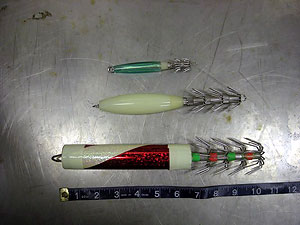

 | |||||||||||
|
|
Journals 2008/2009Heather Judkins
July 31, 2008 Each night there are many activities that occur involving science projects other than the marine mammal operations. The fun doesn't start until one hour after sunset for one hour-this is when the CTD drops and the squid jigging starts. Let's talk squid first. The purpose of the squid project is to determine the northern range for the Humboldt squid, Dosidicus gigas, as well as to study the food web of this area to determine where the squid fall within the extensive food web of the California current. The squid jigging occurs nightly one hour after sunset. This project coincides with the CTD drop, which works well as the ship is stopped for one hour. There are three people jigging with poles, reels, and large jigs using night- lights to catch the squid. The jigs drop to approximately 125m for 20 minutes, 75m for 20 minutes and then around 50m for the last 20-minute interval. To date, we haven't caught one! We have recorded a few smaller animals that we have seen at the surface and we are going to attempt to catch them with large dip nets.
When we catch a squid, it's time to record some important information. After identifying what species it is, if the squid is larger than 30cm (mantle length) then I dissect parts out to be studied later such as the beak, gladius, tissue from the mantle, gills, and sex organs. Smaller squid are labeled and stored in the freezer for future study. For a look at the Humboldt squid, go to www.pnas.org/content/104/31/12948/suppl/DC1 and click on the short movie clips to see how they feed. The Humboldt have a reputation for being aggressive and they move in large schools so the chances are that if we catch one, we will catch multiple animals in the hour timeframe. I have 19 days to catch the big one and have some fun! Stayed tuned! Question 1: Look online and describe the characteristics of the Humboldt squid (include range). Question 2: What phylum are squid in? What characteristics put them there? |
||||||||||

